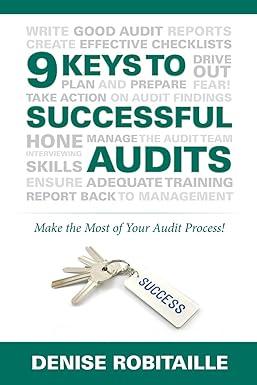Question
Kota Mills supply Divine Denim with the organic denim used in their production. After discussions with Helen about the service she was getting from Good
Kota Mills supply Divine Denim with the organic denim used in their production. After discussions with Helen about the service she was getting from Good Numbers, the manager of Kota Mills decided to use Good Numbers to assist with their management decision making. Kota Mills produces three different weights of denim using two departments. In Department 1, machines weave the cloth. In Department 2 the cloth is dyed a variety of colours. Information for the combined use of resources in both departments for the three types of fabric is outlined below.
Bolts are 20 metres each. All fabric is inspected during production. Robotic equipment inspects the fabric for obvious flaws as the bolts are wound up. Each bolt spends about 5 minutes in the inspection process.
| Denim | |||||
| 8 ounce | 13 ounce | 16 ounce | Total | units | |
| Monthly production in units (bolts of fabric) | 1,000 | 4,000 | 2,000 | 7,000 | bolts |
| Direct material cost $ | 8,000 | 24,000 | 20,000 | 52,000 | $ |
| Direct labour cost $ | 660 | 1,320 | 920 | 2,900 | $ |
| Direct labour hours | 33 | 66 | 46 | 145 | hours |
| Machine hours | 500 | 1,333 | 1,500 | 3,333 | hours |
| Number of set-ups for dye colour changes | 10 | 30 | 20 | 60 | set-ups |
| Inspection time | 83 | 333 | 167 | 583 | hours |
Combined overhead costs for the two departments follow:
| Cost to operate and maintain machines | $ 40,000 |
| Set-up costs | $ 11,000 |
| Inspection costs | $ 6,996 |
| Total | $ 57,996 |
Previously, Kota Mills used a costing system focused on processes. It allocated direct materials to each product separately but allocated direct labour and conversion costs as if they were incurred equally across the units produced. Under this costing system, the overhead cost for Department 1 is $19,332 and for Department 2 it is $38,664. Direct labour hours and costs in Department 1 are 55 hours at $1,100, and the remaining are in Department 2. Direct materials for Department 1 are $15,000 for 16 ounce denim, $16,000 for 13 ounce denim, and $6,000 for 8 ounce denim. The remaining direct materials are added in Department 2. No beginning or ending inventory or abnormal spoilage is recorded for Kota Mills this period.
Required:
- Set up a spreadsheet to perform the calculations in ii. and iii. below. Use a data input section and cell referencing. (2 marks)
- Use conventional process costing to allocate the direct materials and conversion costs per department to total bolts produced. Develop a cost per bolt for each type of fabric. (Hint: You will need to first calculate the equivalent cost per bolt for conversion costs for each department.) (3 marks)
- Using activity-based costing (ABC), develop a cost per bolt. (12 marks)
- Compare the process costing and ABC results. Identify the products with overstated costs and those with understated costs. Explain why the costs are misstated under traditional process costing. (5 marks)
- How could the Kota Mills manager use the ABC information to improve operations? (max 200 words) (3 marks)
Step by Step Solution
There are 3 Steps involved in it
Step: 1

Get Instant Access to Expert-Tailored Solutions
See step-by-step solutions with expert insights and AI powered tools for academic success
Step: 2

Step: 3

Ace Your Homework with AI
Get the answers you need in no time with our AI-driven, step-by-step assistance
Get Started


